The Bottom Line
Nintendo's new Switch console-handheld hybrid might be the most interesting gaming device I've ever owned. The system's unique two-in-one form factor lets it transform into a portable handheld for quality gaming on-the-go, or dock into its included cradle to play games on a big screen HDTV in your living room.
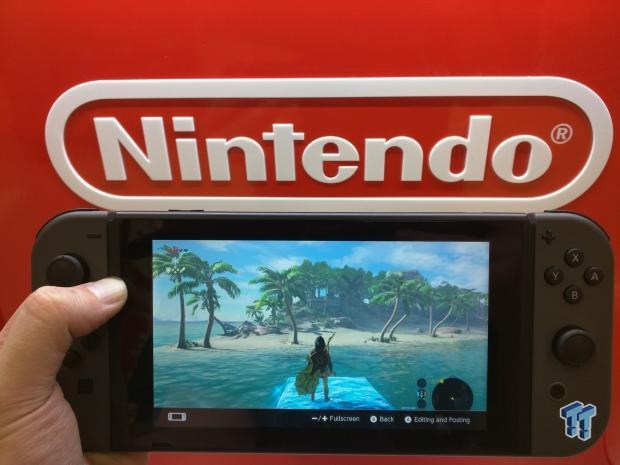
The device is extremely liberating and is truly a revolution on Nintendo's part, tapping into the "gamer's dream" of being able to take console-quality gaming anywhere you go. But the Switch has its drawbacks, too, and doesn't hit its full potential right out of the gate. Is it worth buying now, or should you wait?
Before we discuss the Switch's merits and evaluate its value for gamers in its current state, let's talk about what the Switch actually is.
Nintendo Switch: what is it, and what does it do?
Nintendo's new system merges both handheld and console gaming together in three different modes: TV Mode, Handheld Mode, and Tabletop Mode.
Using a 6.2-inch capacitive touch "tablet" with two detachable JoyCon controllers, the Switch can be played as a traditional handheld with the JoyCons attached via Handheld Mode. By detaching the JoyCon controllers and handing one to a friend, the Switch also transforms into a mini arcade machine via Tabletop Mode for fun co-op or competitive gaming experiences. If that wasn't enough, the Switch can be docked in its cradle via TV Mode to beam its video signal to a HDTV for basic couch-based living room play.
Despite the Switch being a "home console first and foremost," it uses a highly customized NVIDIA Tegra X1 superchip, which powers both NVIDIA's mobile Shield Tablet and Shield Portable devices as well as its Android-based Shield TV set-top box. The NVIDIA Tegra X1 is pretty potent on its own, but the Switch's chip is scaled back to ensure cohesive performance synergy across handheld and console platforms.
So the Switch's multi-form factor flexibility comes at a cost: the device is only a fraction as powerful as an original PS4 or Xbox One.
This power discrepancy means the Switch won't hit the same performance of fidelity as its console competitors, but at the same time, it doesn't have to--the Switch lives in its own unique cross-over world taps a wealth of handheld and mobile gaming potential current consoles just aren't capable of.
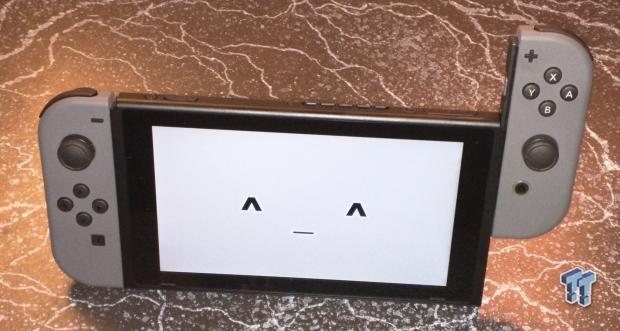
As Nintendo fan can tell you, power isn't everything.
There's magic to be found in this device. Honestly, it's a very unique and exciting piece of hardware that does one thing extremely well: giving console gamers a new sense of freedom.
The Switch delivers clear high-definition gaming experiences as a handheld, so it genuinely feels like a mini console rather than a 3DS successor. As a 3DS owner, I find the handheld's lower resolution to be a problem, but the Switch completely smashes this problem head on.
Being able to instantly slot out the Switch and continue my same exact playthrough without any disconnections, hassles, or extra fees is a one-of-a-kind feeling.
What's more is that the Switch doesn't just switch its form factors, it actually switches up its internal hardware depending on which mode it's in.
Read Also: Full Nintendo Switch hardware specifications
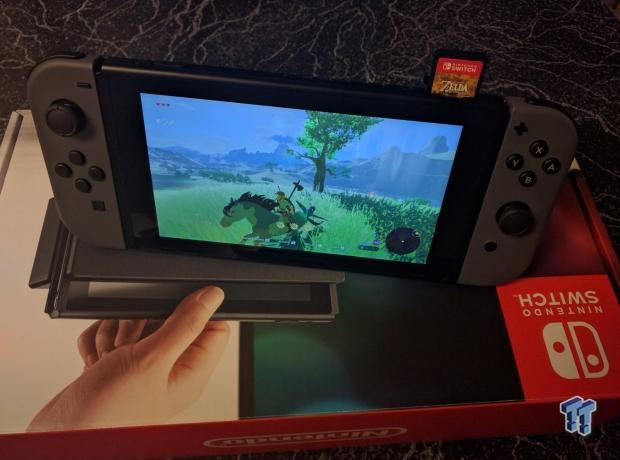
Handhelds typically have scaled-back hardware to ensure the device doesn't suck away too much battery and get too hot, and the Switch is no different. However, the Switch actually unlocks its NVIDIA Tegra X1 GPU when docked in TV Mode, improving visual fidelity and games performance.
Remember that the Switch's 6.2-inch tablet handheld screen is locked to 720p, so all games will play at a native 1280 x 720 resolution on the handheld, and be upscaled to 1920 x 1080 on Full HD television sets.
Games can and--often will--perform and look differently in Handheld Mode versus TV Mode due to this internal scaling and resolution discrepancy. On average games will be better on TV Mode than Handheld Mode, but how wide these performance deltas are depends entirely on devs.
Certain games like Zelda: Breath of the Wild look and play amazingly on both Handheld and TV Mode, despite a 720p resolution in Handheld Mode and a 900p resolution on TV Mode. But not all games enjoy this success: Dragon Quest Heroes II drops to ~20FPS and looks quite good when in TV Mode, but when put in Handheld Mode the game's fidelity, lighting effects, and draw distances take a substantial hit.
This means that how well a game plays across the Switch's different modes is entirely dependent on developers. If a game isn't scaled or optimized properly, it may be playable, but just not where it should be. Nintendo has affirmed that the Switch is incredibly easy to developer games for, and the system supports modern games engines like Unreal Engine 4 and Unity as well as APIs such as Vulkan and OpenGL.
Just consider this possible performance discrepancy something you should be aware of.
Now let's talk about my personal experiences with the console, starting with my impressions of the Switch's three different modes.
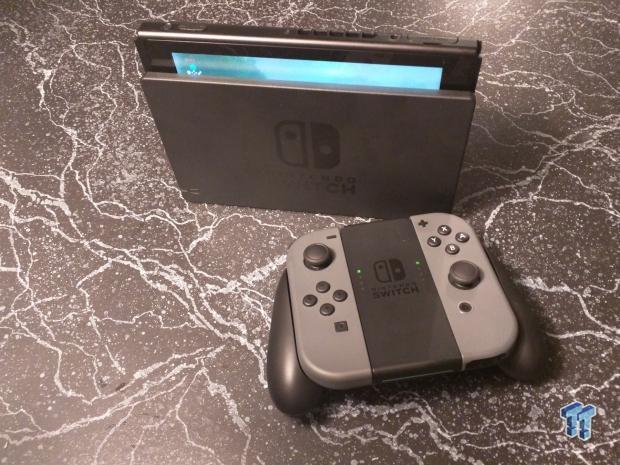
TV Mode
TV Mode, aka "docked play," is the mode I spent the most time with. I'm a traditional console and PC gamer. I typically enjoy my gaming sessions at about 2-3 hours at a time in a stationary room, preferably a living room with a couch. So the Switch's TV Mode really felt the most natural for me and fit my current gaming environment.
One thing that impressed me is how fast and easy the Switch works its magic. Just slot the Switch into its docked cradle, and within half a second Zelda: Breath of the Wild was zapped to my 50-inch 1080p HDTV. Within seconds I picked up right where I left off on my on-the-go session.
There was no fuss, no annoying navigation issues, sign-ins or anything like that: the "switch" to TV Mode was instantaneous and just worked. I'd really like to emphasize that point: the Switch just works. I experienced absolutely zero problems with the mobile-to-TV signal switching, and it zapped just as fast as it does in the Switch advertisements.
The Switch plays its games in TV Mode exceptionally well, and the games themselves are clear, brilliant, responsive and genuinely fun. Zelda performs near-flawlessly, and I only noticed a few minor FPS drops when fighting enemies in areas with tons of lighting/atmospheric effects.
I'd also like to stress the device itself takes hardly any time to fire up, and in no time at all you're gaming.
That's how consoles should be--no fuss, no nonsense, no long loading sequences...just quick, lightweight OS software that lets you jump right into your favorite gaming experiences.
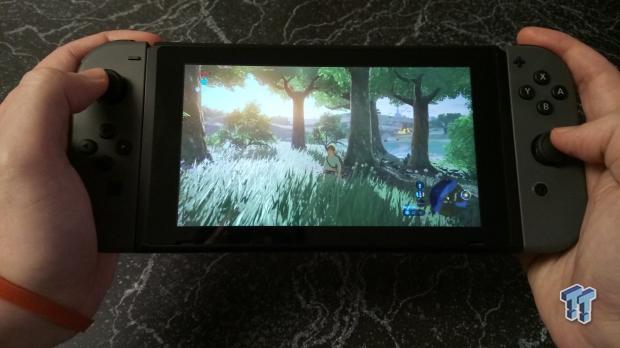
Handheld Mode
Handheld Mode will likely be the Nintendo Switch's main selling point, and rightly so: the system shines bright with its on-the-go play.
The Switch's 6.2-inch panel is vibrant and genuinely makes you feel like you're holding a miniature HDTV in your hands. The effects in Zelda: Breath of the Wild are crisp and clear, making reflections, water, atmospheric fog and other environmental effects look exceptionally beautiful. It's quite refreshing to play games in 720p HD resolution on a handheld, especially since most handhelds often take a hit on visuals and resolution (look at the 3DS and PS Vita, for example).
I'm thoroughly impressed with how games look on the Switch's display, and the resolution genuinely makes the games feel more like their console counterparts.
The Switch itself feels comfortable and solid in your hands, too. Since it lacks a clamshell mechanism, it's not as rugged and portable as the 3DS, but the display and JoyCon controllers make up for it in dividends. Despite any real ergonomics like the Wii U Gamepad, the Switch just fits in your hands and feels comfortable without any specific contouring.
One of the best things about Handheld Mode is that the Switch games are self-contained for offline play. So a portion of a game won't be locked behind online features--even games with online play like Splatoon 2 will have extensive offline LAN support. You can take the Switch with you anywhere and fire up Zelda on the go, or play some Shovel Knight with your friends in Tabletop Mode without worrying about internet connectivity.
Audio in Handheld Mode works fine, but I will say it's unfortunate that wireless Bluetooth headsets aren't supported.
All in all, Handheld Mode is functional, well-designed, and genuinely fun. Sadly the Switch's LCD screen doesn't do well in sunlight at all and glares quite a bit. Then again, my phone basically does the same thing.
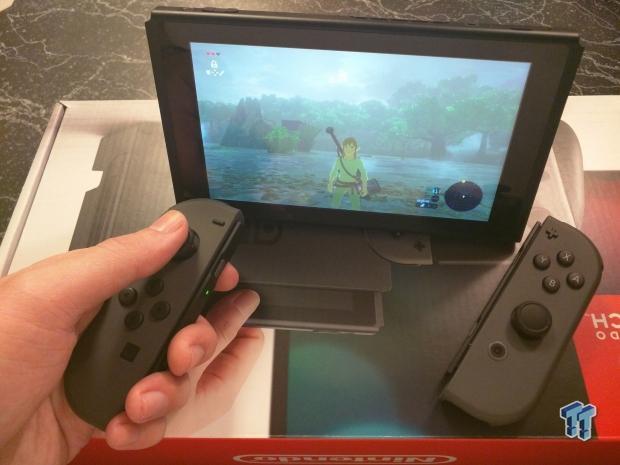
Tabletop Mode
Tabletop Mode is a rather ingenious move on Nintendo's part, and arguably the most important mode insofar as social interactivity.
This feature is all about sharing the fun. Every single Switch console can transform into a portable two-player arcade machine, basically making the device infinitely accessible. It's perfect for building engagement, and every Switch owner basically acts like a walking advertisement for the system.
With the ability to detach the JoyCons and hand one to a friend to play games, every Switch is a demo unit. Since the Switch is something you have to see and experience yourself to believe--especially the included JoyCon controllers--Nintendo completely solved this issue with Tabletop Mode.
The JoyCons can be turned sideways and transformed into mini SNES style controllers, facilitating easy on-the-go two player fun for everyone. Plus you can even buy more JoyCons or Switch Pro controllers to play with more people on the same Switch.
Now I will say that using the JoyCons when turned sideways isn't the best.
The controllers function well and are impressive, to say the least, but they're small, and your fingers are quite cramped. Plus the lack of a D-pad will make some old-school Virtual Console games feel weird.
Tabletop Mode is extremely satisfying for one-player gaming too. Being able to use two controllers in either hand is quite liberating and enjoyable, and it's not something I can really be put in words. Imagine having the freedom of sawing your DualShock 4 or Xbox One controller in half and holding them in each hand, similar to HTC Vive wands--or even dual WiiMotes.
It's quite enjoyable and fun using the JoyCons like this in Tabletop Mode and adds a new dimension to on-the-go portability.
Just be sure your Switch is stable!
The device has a kickstand, but it's not that good on certain surfaces. I will say, however, it can be quite amazing on surfaces like Magic: The Gathering playmats and mousepads! I'd also like it if the Switch had two detachable kickstands to help improve stability.
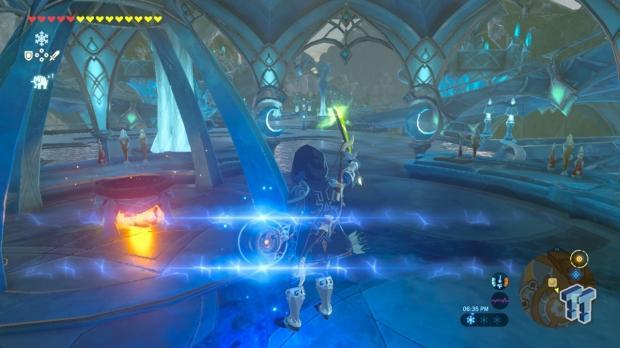
Game performance
My gaming experiences with the Nintendo Switch have been quite favorable.
While I've only played a few games like Shovel Knight: Treasure Trove, a low-res bit-style platformer, and Zelda: Breath of the Wild, Nintendo's massive new open-world adventure that happens to be the most demanding game on the platform, I'd like to think that developers will continue properly optimizing their games on the system in the future.
But from what I have played, I can honestly say the Switch isn't a gimped or cut-rate games platform. Whether in 720p in Handheld Mode or full 1080p on a TV, the Switch can deliver breathtaking, dynamic fantasy world experiences alongside traditional, fun platformers.
It's actually kind of funny when you think about it.
The gaming world is pushing towards 4K HDR with Sony's PS4 Pro and Microsoft's Project Scorpio console, but Nintendo comes along and shows us that 900p graphics can blow us away. Nintendo has a long history of showing us that graphics don't always matter, and I think the Switch will be both a continuation of this ethos, as well as Nintendo's penchant for unique console hardware and software.
The JoyCon controllers are responsive and liberating, and the Switch Pro controller is absolutely amazing. The Switch performs well across all three of its modes, mirroring performance and content while keeping things easy and accessible.
Overall the gaming experience on the Switch is multi-faceted, exciting, unique and genuinely enjoyable. The console's Tegra X1 chip is potent enough to maintain impressive experiences that, while not as rich or dynamic as PS4 or Xbox One, completely exemplify Nintendo's charm and dedication.
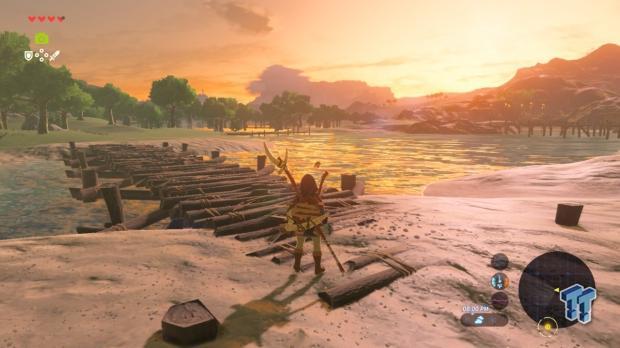
But I do have to say that I am a bit worried that publishers and devs may sloppily optimize specific ports of their games.
Reports indicate Dragon Quest Heroes II runs at sub-20FPS on the Switch during battle sequences and 30FPS in exploration mode. Considering Dragon Quest Heroes is a Musou game with a heavy emphasis on battle, you'll be playing most of the game at ~20FPS, making for a choppy experience.
On the other hand, games like Fast RMX highlight just how far Nintendo has come with the Switch.
Fast RMX uses adaptive, dynamic resolution scaling to scale the in-game resolution between 900p and 1080p while docked to maintain 60FPS.
Fast RMX also hits 60FPS on the Switch's 720p handheld screen while taken on the go.
This technique is what PS4 and Xbox One games do (especially the latter) to hit a consistent frame rate at the cost of lowered visual fidelity.
Only time will tell how well the games are optimized, but based on how Zelda: Breath of the Wild and Fast RMX play on the Switch, we know the device is capable of impressive things. I just hope more developers tap this potential.

Heat and thermals
The Nintendo Switch stays remarkably cool and barely gets warm while played in Handheld Mode or Arcade Mode.
I knew that the NVIDIA Tegra X1 chip is quite efficient with its thermal management and power, but the Switch takes it to a whole different level. Even when I fully discharged the battery by playing Zelda for more than 3 hours, the Switch barely got warm to the touch.
Now the lower temps are because the Switch scales back its internal GPU in Handheld or Arcade Mode, thus drawing less power and pushing out less heat. This scaling or "switching" of internal power also means better battery life (and the Switch has decent battery life, more on that in the next section).
The Switch itself gets hottest around the middle area of the tablet: that's where the internal L-shaped copper heat pipe sits, absorbing the heat, which is then dissipated by an internal fan. The heat is then passed through a special ventilation grill at the top of the Switch.
The Switch also doesn't get very hot when charging via the included AC adapter, which can discharge up to 39W to the system over USB Type-C.
However, the Switch console does get a bit hot when docked and played in TV Mode. This is because the Switch's internal GPU is fully unlocked and can hit up to 1080p 60FPS performance depending on the game, and maintain rather lush and visually appealing atmospheric effects and lighting.
After about 2-3 hours of playing Zelda: Breath of the Wild in TV Mode, I pulled out the Switch and noticed it was decently warm. It wasn't hot by any measure, not as hot as my Nexus 4 or Nexus 6 can get when charging, but it was indeed warm.
Also, remember that this heat could technically be compounded by the power that's being directly supplied to the Switch while it's docked. The Switch won't charge if it's at maximum capacity, of course, but if its battery is low and it's docked, the charging could push thermals up in conjunction with the unlocked performance.
All in all the Switch runs cool and has a surprisingly decent heat management system to ensure it doesn't overheat across all modes.
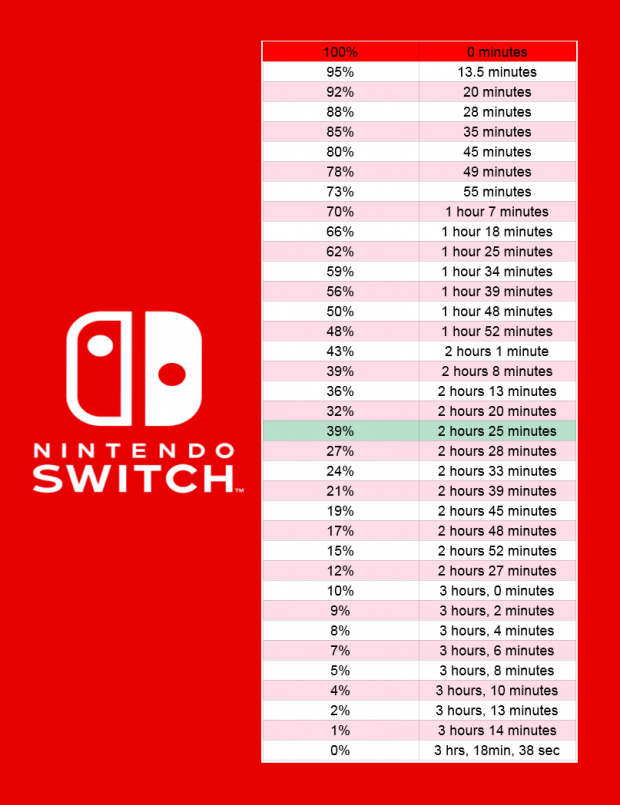
Battery life
Since the Switch is branded as a portable console, battery life is extremely important.
I'm happy to report that the Switch has pretty good battery life.
As we reported in our Nintendo Switch battery life test, the device can maintain 3 hours, 18 minutes and 48 seconds of Zelda: Breath of the Wild gameplay on-the-go at about 60-65% screen brigthness in Handheld Mode.
The Switch has a 4310mAh battery that takes about 4 hours to completely recharge on the dock, but our times were a bit less in Handheld Mode, as we used the included AC adapter that pushes 15V 2.6A of charge. In docked mode, the Switch recharged slower while gaming, of course, but maintained a decent recharge rate when the system was put into sleep mode.
All in all, it took us about 3 hours and 30 minutes to recharge the Switch to max capacity.
The controllers have amazing battery life. The JoyCons can last up to 20 hours, and the Switch Pro lasts 40 hours. After more than a week of use, I've never had my Switch Pro or JoyCons run out of power. I've only had to recharge my Switch Pro controller once or so, and even then the controller wasn't even low!
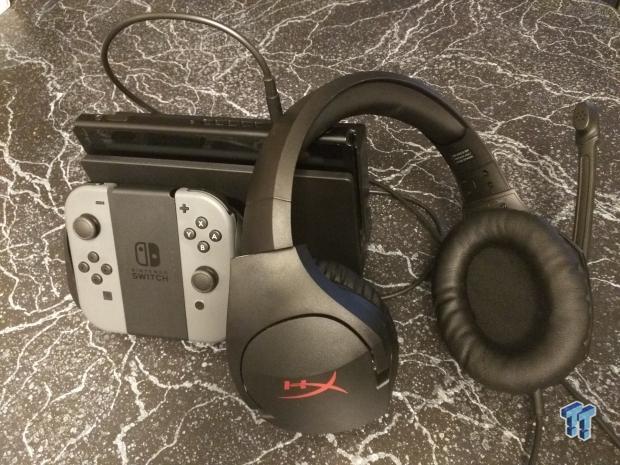
Audio
Nintendo's Switch console handles audio well but doesn't go above and beyond. It's essentially like a mobile phone or tablet in terms of audio, using built-in speakers and a standard 3.5 mm headphone jack for headphone support.
The tablet has decently powerful built-in speakers that ensure you won't miss any dialogue or action when playing on-the-go. But if you're playing in Handheld Mode you'll want to use headphones for the optimum experience.
To test headphone audio on the Switch, we used HyperX's impressive and affordable Cloud Stinger headset.
HyperX's Cloud Stinger model is a great fit for any gamer, costing just $49.99 while delivering awesome sound quality. And the Cloud Stinger is extremely comfortable: I played Zelda: Breath of the Wild for about an hour while on-the-go with the Cloud Stinger on my ears, and I didn't have any aches or soreness.
The Cloud Stinger had great audio performance, and everything sounded crisp and clear. I'd absolutely recommend playing Zelda: Breath of the Wild with headphones, as you'll hear every little thing. Link's armor and weapons clinking as he runs, the soft billowing of the trees and leaves, the rushing water, the hilariously and whimsical NPCs--all of it has a new dimension of interactivity when experienced with headphones.
Unfortunately, the Switch isn't really designed to use headphones outside of Handheld Mode.
The Switch doesn't play too nicely with headphones in docked TV Mode. The system's 3.5mm headphone jack is exposed when docked, and the Switch will indeed output audio to headsets while docked, but you'll need a really long cord to stretch across your room.
Unlike the DualShock 4 and Xbox One controllers, the Switch Pro controller doesn't have a headset jack.
So you have two options if you want to use headphones while playing in TV Mode, and both of them require long cords. You can either hook your headphones up directly to the Switch or hook them up to the TV itself.
I'd recommend the latter since you can adjust the volume remotely--the only way to adjust the volume when plugged into the Switch is via the volume rocker at the top.
Sadly, the Switch does not support wireless Bluetooth headphones, so you'll have to be wired the whole time.
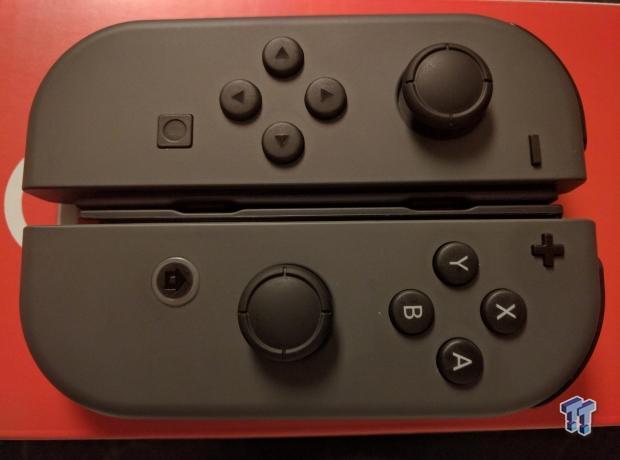
JoyCons
The Nintendo Switch's JoyCon controllers are revolutionary but also quite derivative. If anything, the JoyCons are the natural evolution of the WiiMotes, featuring a transforming tri-form factor usability that transcends a WiiMote's functionality.
But they're small. Very small. I have smallish hands and they even seem small to me! But they're not totally unusable, and their petite size is fitting with the system's portability.
Despite their size, I'm quite impressed with the JoyCon controllers.
They have amazing battery life, function well, and you can turn a single JoyCon sideways to use as a single self-contained mini controller for co-op or competitive fun on the Switch, and even turn it upright to use as a kind of bomb detonator-like button for games like ARMS.
The accelerometer and gyroscopic tracking work very well and essentially allow you to have a Wii U gamepad as well as two WiiMotes at any given time. Using the right JoyCon to aim my bow in Zelda is responsive, intuitive, interactive and satisfying, and I often find myself moving the Switch tablet around when looking through Link's spyglass.
The HD Rumble is a nice touch and feels satisfying, giving you a nice little jolt of feedback in a game. Overall the JoyCons are quite satisfying and work well.
But at the same time I do feel like the JoyCons are a bit...well...cheap.
The JoyCon Grip isn't the best, either.
The included JoyCon Grip doesn't recharge the actual controllers, but that's not that big of a deal. The JoyCons automatically pull from the Switch's battery when attached to the tablet. The JoyCon Grip does, however, feel odd to use at first, and doesn't make for the best-included controller. You'll have to shell out another $30 for a JoyCon Charging Grip or other accessories to recharge the controllers without attaching them to the Switch.
Since the JoyCons are modular and can be used in four different ways (one separate in either hand, turned sideways, turned upright, and combined in the JoyCon Grip), it makes sense the controllers aren't the best for dedicated TV Mode console play.
Playing Zelda using the JoyCon Grip is serviceable, but it does feel odd, as the rounded edges will dig into your palms.
If you plan to use the Switch primarily as a console in TV Mode, buy a Switch Pro controller. More on that later.
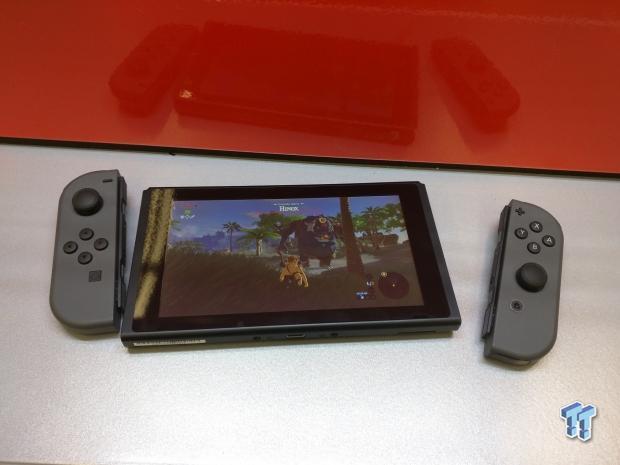
The face buttons are very, very small--literally the same size as the AXBY buttons on a 3DS XL--and the analog sticks, while serviceable and functional, do feel...cheapish. Although they are nowhere near as cheap as the circlepad pro. But I do feel like with a few months use I might have to replace the JoyCons.
Also, the JoyCons don't have an actual D-pad.
This is because the left JoyCon's D-Pad is split so it can be used as the regular face-buttons in Tabletop Mode. So playing platformers like Shovel Knight feels odd and awkward. With practice, you can absolutely use a split D-pad, but it's not really as fun.
The JoyCon's analog sticks also feel kind of awkward when used for platformers. This is likely why Nintendo delayed the Switch's Virtual Console offering because the included JoyCons may not play too well with older NES and SNES titles.
Furthermore, the JoyCon's surface is a kind of silicon that will react badly to specific covers, eating through the surface and leaving ugly splotches.
Despite all these potential drawbacks, the JoyCons remain solid. Being able to use two controllers in either hand to play a game is quite impressive, and I've had no problems with my JoyCons. In fact, our controllers stretched an incredible 37 feet away from the console and still operated!
The JoyCons are an interesting feat of technological prowess and genuinely feel less like a gimmick and more like the natural evolution of Nintendo's past interactive controllers. But they aren't without their flaws!
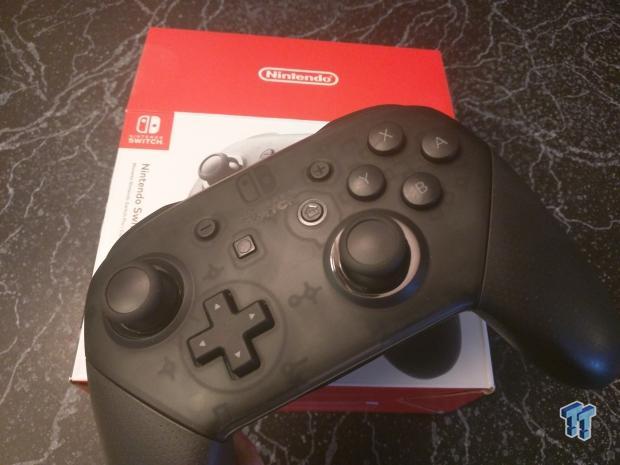
Switch Pro controller
I'm in love with the Switch Pro controller. It's quite possibly the best controller I've owned. I just wish it had a normal AXBY layout!
The Switch Pro controller feels incredible in your hands. It checks all the right boxes and does what you want a controller to do: it's extremely comfortable, has amazing battery life, great analog sticks, great D-pad, big face buttons, and the triggers are very, very nicely made. It also rocks all of the high-end tech that makes the JoyCons so great, including HD Rumble, accelerometers, and gyroscopic sensors. And, of course, it has an impressive range thanks to its built-in Bluetooth radio.
The triggers actually slightly float but don't feel cheap like Sony's DualShock 4 triggers. The analog sticks have a skewed axis like an Xbox 360 or Xbox One controller for awesome comfort. Everything about this controller screams quality and dedication.
There's only one problem: it's $70. Other the price and no headphone jack, I can honestly find no faults with this controller.
So do you need a Switch Pro controller? Do you have to buy one to get the most out of the system?
It depends. Do you plan to use your Nintendo Switch primarily in TV Mode and treat it like a home console? Then yes, buy one. Buy one fast and don't think twice--you'll be glad you did.
There are certain things the Switch Pro controller has that the JoyCons don't, including an actual D-pad, big comfortable buttons, a contoured grip that fits right in your hands, big triggers, and high-quality joysticks. Of course, the Switch Pro can't be separated into two mini controllers, so there's that.
But if you plan to use the Switch primarily as a portable system, then you don't have to grab it.
Sure it's great to use the Switch Pro controller in Tabletop Mode, and the high-quality controller does feel great, but it's not a must-have. And the Switch Pro controller isn't exactly portable.
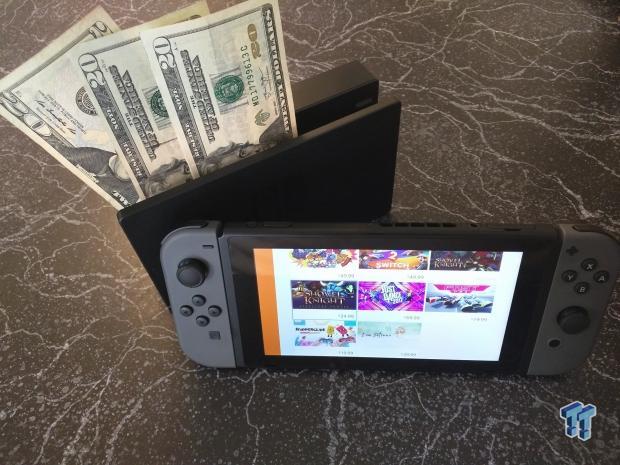
Cost: Frugal gamers beware
Like any new system or console, the Switch is expensive.
But the Switch isn't just outright expensive: it has a galaxy of add-ons and accessories that will quickly inflate the price to rather uncomfortable levels. For example, a single game and a controller cost almost half as much as the Switch's overall price.
Suddenly a $299 Switch turns into a $436 with a game and a Switch Pro controller. And it doesn't stop there!
The Pro controllers and extra JoyCons are $70 each, and you can buy a single replacement or extra JoyCon for about $50. Then there are the $30 JoyCon Charging Grip, $30 console cases, $5 to $10 screen protectors, $20-30 microSD cards, charging stands, Tabletop Mode stands, JoyCon slip-covers--the works. If you're not careful, you can end up paying $600 or so on the Switch.
Also Nintendo Switch games may end up being more expensive than other platforms, too. Indies like Rime and Binding of Isaac: Rebirth are $40 on the Switch, and yes both of these games have physical cartridge releases, but the cost is still somewhat of a deterrent.
Games like 1-2 Switch, which should've been a pack-in title to show off the JoyCon's features, cost $40 too.
Furthermore, the Switch has a marked lack of launch games. Right now there's approximately nine major launch releases on the US eShop and an assortment of Neo Geo games for $7.99 each.
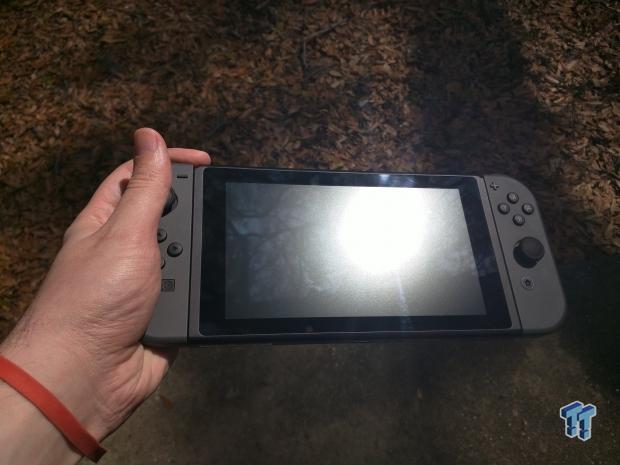
The Switch has over 100 games currently in development by over 80 developers, and major third-party publishers like Square Enix, EA, Activision, Take-Two, Ubisoft and many more have pledged support. Plus we have a galaxy of indie games launching onto the Switch. But those games aren't here yet.
Apart from Zelda: Breath of the Wild, Shovel Knight, and a few Japanese titles, the Switch doesn't have that much to offer. So if you're not interested in Zelda, hold off for now, because the pickings are indeed slim.
Sadly, there are no Virtual Console games just yet. That means no old-school NES, SNES, Nintendo 64 or the rumored Gamecube titles on the Switch.
If you're a frugal gamer who wants to get the Switch, then here's my advice: wait.
Right now the Nintendo Switch is an investment. You don't want to buy a Switch thinking otherwise. Purchasing a Switch right now means you're comfortable with the early adopter trade-offs that affect all new platforms and consoles, including missing features, sparse games lineup, and rocky hardware start (JoyCon issues, scratches from the Switch dock, etc.).
Bear in mind that the full Nintendo Switch cost isn't even really here just yet. Nintendo will roll out a paid online subscription service that's required for multiplayer, but the service will be quite cheap at around $18 to $26 a year.
All of these things need to be taken into consideration before buying a Switch.
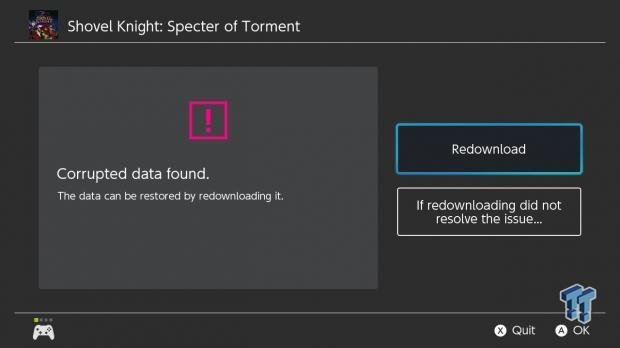
Problems we experienced
Our experiences with the Nintendo Switch have been near-flawless.
We had no issues with the tablet freezing up, no dead pixels, no broken internal components or overheating problems. Our left JoyCon works just fine and even worked 37 feet away from the system. The JoyCons lock perfectly into their rails and don't slide out, and we've yet to have a problem with the controllers' surfaces.
Our Switch dock didn't scratch the screen (although that's likely because I'm very, very careful docking and undocking!) and console-to-TV video signal switching works just great.
But we did have one issue, and it was a scary one: corrupted save data.
I'm still not sure how this happened, but my Specter of Torment game download ended up getting corrupted.
Luckily this wasn't my actual in-game saves (the Switch separates saved data from actual game downloads), and a simple re-download fixed everything. But it did bring to mind a glaring problem the Nintendo Switch has, and that's no way of backing up or migrating game saves.
That's right: Switch owners can't make copies of their saved games. All game saves are stored onto the system's 25.9GB of usable memory (advertised as 32GB, but 25.9GB is all you really get), and right now there's no way to move said data.
So if your Switch's eMMC flash storage chip dies, or your send the Switch in for repairs, there's a chance you'll lose all your data.
Spent 150+ hours in Zelda: Breath of the Wild? That data could be lost forever. Got a perfect game in Shovel Knight Treasure Trove? All of your pixellated awesomeness could be wiped clean.
Nintendo needs to change this, and fast.
Now it's worth mentioning that Nintendo America President Reggie Fils-Aime hinted that Nintendo may let users upload their saves to the cloud, similar to Sony's PS Plus, but we need this feature now.
Cloud saves could be included as a perk in the paid online subscription plan, but it's something gamers need right now instead of later.
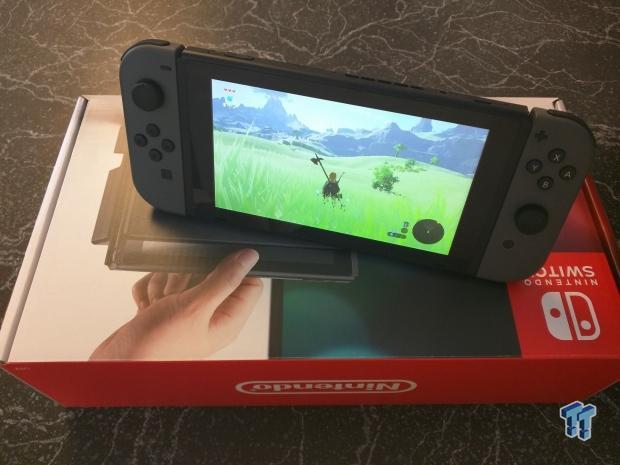
Should you buy it?
The Nintendo Switch is an impressive piece of hardware that has tons of potential. But is it worth buying now? To answer that, you have to ask yourself what kind of gamer you are.
If you're the type of gamer that spends long 2-3 hour+ gaming sessions in a living room or other stationary place, be it console or PC, and don't play games on the go, then you may want to think twice.
The Nintendo Switch is specifically made for people who want to seamlessly integrate gaming into all aspects of their lives. The Switch is a social device, it's something fun, hip, new and interactive that can be enjoyed with friends anywhere and everywhere--but it's also a home console that delivers a traditional experience.
The Switch itself is meant to supplement your gaming habits by meshing easily and painlessly into your everyday life. Fire up Zelda while riding the bus to work, or play some Snipperclips with your friend on your lunch break. And then when you're done, you can come home and slot your Switch into its dock to pick up right where you left off.
To get the most out of the Nintendo Switch, you'll need to take it with you and share it. The current console market doesn't do well with that kind of social spirit--games don't even really do split-screen co-op anymore!
This is the magic of the Nintendo Switch, but it's also something that could push gamers away from it. The Switch converges all facets of the gaming world into one easy-to-use and relatively powerful device, but it absolutely won't replace your gaming PC or PS4 or Xbox One.
The Switch breaks the mold by making gaming more active, accessible, social and interactive than we're used to. So if you want to get it, be aware of what it does and doesn't do--we hope that this review has made those points clear.
Since it's brand new, the Switch doesn't have extra features and music or video streaming. There's no Netflix, Hulu, YouTube, or Amazon Prime Video app. It has no usable web browser for internet viewing. The Switch is a dedicated games machine, and while that might change in the future, right now it doesn't have any ancillary features.
It will, however, charge your phone, tablet, or even your DualShock 4 controller via its dock, and even supports USB keyboards for typing out screenshot memes.
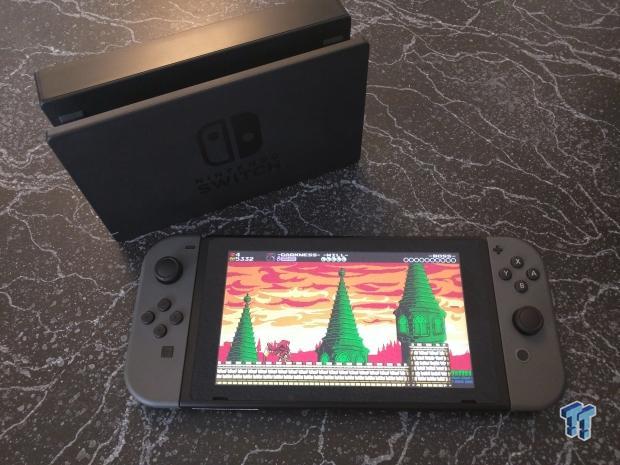
Final Thoughts
I've seen other websites say the Nintendo Switch is a jack of all trades and a master of none. I don't think that's true.
I think the Switch is the best handheld on the market right now in terms of potential, power, and cross-utility. Sure it doesn't have very many games right now and launched with fewer titles than the Wii U and 3DS handheld, but it does something no other device does: delivers high-quality handheld and console gaming in the same device.
Nintendo's new console-handheld hybrid isn't just a new gimmick: it's the future of Nintendo. This device represents years of planning and forward-thinking on Nintendo's part, and I am quite confident the Switch will tap a unique unified market that facilitates the "gamer's dream."
Being able to seamlessly transform the Switch from a handheld to a mini arcade machine and a console is a rather magical experience, and it's something you really have to see and experience to believe. Nintendo absolutely has something special here.
The Switch hasn't hit its full potential just yet, but it's still young and green, not wizened and hearty like the 3DS handheld. Over time, the Nintendo Switch will rack up games, features, and support to make it a must-have system that compliments our daily gaming habits.
Despite it's faults, despite the missing features and games, I'm thoroughly impressed with the Nintendo Switch, and I for one can see the device rocketing Nintendo back to its glory days. The Switch is social, interactive, and genuinely enjoyable for everyone.
At it's heart, the Nintendo Switch represents the core ethos of Nintendo enchantment: fun above all else.
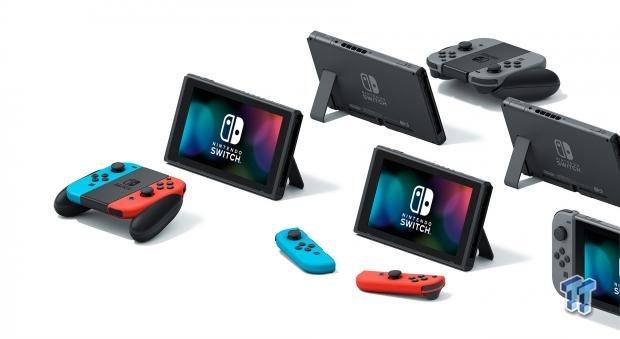
What's Hot
- Seamlessly switches across all modes
- Impressive gameplay performance, effects and visuals
- Social, interactive and fun
- Fast start-up
- Decent audio, support for headphones
- 720p HD screen looks great
- Responsive resolution and performance scaling
- Doesn't get hot while charging and playing
- eShop games are region-free!
- Storage is expandable with micro SDXC cards up to 2TB in size
- Joycons are fun and functional
- Switch represents the trifecta of gaming (handheld, mobile, console) and offers three different modes of play
- Switch Pro controller is very comfortable
- Decent battery life while on the go
- Ability to play with anyone at any time transforms the system into a mini arcade multiplayer machine
- Being able to take screenshots and share them on Facebook and Twitter
What's Not
- Needs more games!
- No Miiverse
- Content offering is light--no apps or media functionality
- JoyCon Grip is a bit funky
- No wireless Bluetooth headset support
- Can't migrate saved games over to SD cards or backup our saved game data
- Only 25.9GB of internal storage
- Short-ish AC adapter cord
- Not great in sunlight
- May not appeal to current console or PC gamers
- Lots of accessories so the costs can add up super fast
- Can't export screenshots to USB sticks
For more Switch coverage check out our massive Nintendo Switch coverage index!
| Gameplay & Value | 85% |
| Graphics | 80% |
| On-The-Go Performance | 95% |
| Docked Performance | 90% |
| Overall | 88% |
The Bottom Line: Nintendo's new Switch handheld-console hybrid has incredible potential, but early adopters need to know that potential isn't here just yet. Right now the Switch is an investment.
PRICING: You can find products similar to this one for sale below.
 United
States: Find other tech and computer products like this
over at Amazon.com
United
States: Find other tech and computer products like this
over at Amazon.com
 United
Kingdom: Find other tech and computer products like this
over at Amazon.co.uk
United
Kingdom: Find other tech and computer products like this
over at Amazon.co.uk
 Australia:
Find other tech and computer products like this over at Amazon.com.au
Australia:
Find other tech and computer products like this over at Amazon.com.au
 Canada:
Find other tech and computer products like this over at Amazon.ca
Canada:
Find other tech and computer products like this over at Amazon.ca
 Deutschland:
Finde andere Technik- und Computerprodukte wie dieses auf Amazon.de
Deutschland:
Finde andere Technik- und Computerprodukte wie dieses auf Amazon.de
Similar Content
Related Tags

